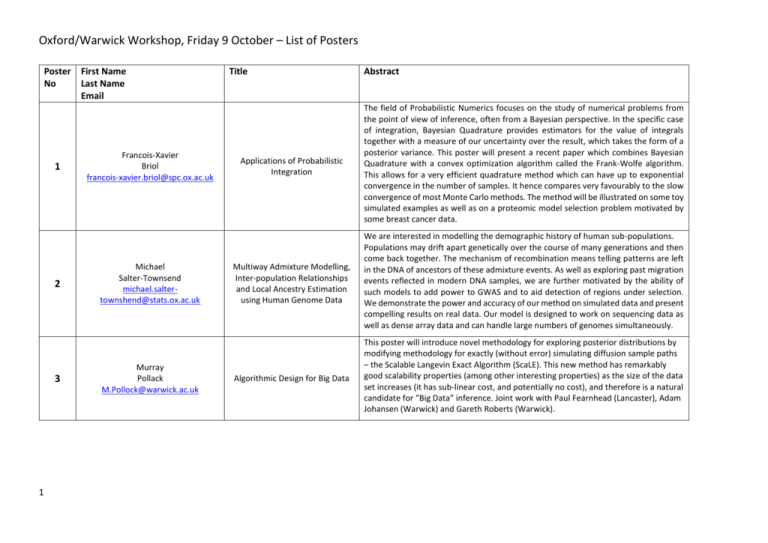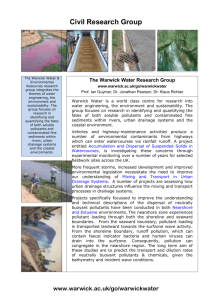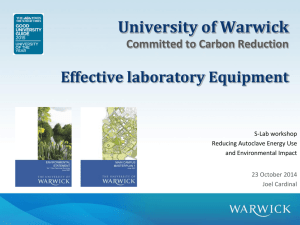File
advertisement

Oxford/Warwick Workshop, Friday 9 October – List of Posters Poster No 1 2 3 1 First Name Last Name Email Francois-Xavier Briol francois-xavier.briol@spc.ox.ac.uk Michael Salter-Townsend michael.saltertownshend@stats.ox.ac.uk Murray Pollack M.Pollock@warwick.ac.uk Title Abstract Applications of Probabilistic Integration The field of Probabilistic Numerics focuses on the study of numerical problems from the point of view of inference, often from a Bayesian perspective. In the specific case of integration, Bayesian Quadrature provides estimators for the value of integrals together with a measure of our uncertainty over the result, which takes the form of a posterior variance. This poster will present a recent paper which combines Bayesian Quadrature with a convex optimization algorithm called the Frank-Wolfe algorithm. This allows for a very efficient quadrature method which can have up to exponential convergence in the number of samples. It hence compares very favourably to the slow convergence of most Monte Carlo methods. The method will be illustrated on some toy simulated examples as well as on a proteomic model selection problem motivated by some breast cancer data. Multiway Admixture Modelling, Inter-population Relationships and Local Ancestry Estimation using Human Genome Data We are interested in modelling the demographic history of human sub-populations. Populations may drift apart genetically over the course of many generations and then come back together. The mechanism of recombination means telling patterns are left in the DNA of ancestors of these admixture events. As well as exploring past migration events reflected in modern DNA samples, we are further motivated by the ability of such models to add power to GWAS and to aid detection of regions under selection. We demonstrate the power and accuracy of our method on simulated data and present compelling results on real data. Our model is designed to work on sequencing data as well as dense array data and can handle large numbers of genomes simultaneously. Algorithmic Design for Big Data This poster will introduce novel methodology for exploring posterior distributions by modifying methodology for exactly (without error) simulating diffusion sample paths – the Scalable Langevin Exact Algorithm (ScaLE). This new method has remarkably good scalability properties (among other interesting properties) as the size of the data set increases (it has sub-linear cost, and potentially no cost), and therefore is a natural candidate for “Big Data” inference. Joint work with Paul Fearnhead (Lancaster), Adam Johansen (Warwick) and Gareth Roberts (Warwick). Oxford/Warwick Workshop, Friday 9 October – List of Posters Poster No 4 First Name Last Name Email Matt Moores M.T.Moores@warwick.ac.uk Title Scalable Inference for the Inverse Temperature of a Hidden Potts Model Abstract The Potts model is a discrete Markov random field that can be used to label the pixels in an image according to an unobserved classification. The strength of spatial dependence between neighbouring labels is governed by the inverse temperature parameter. This parameter is difficult to estimate, due to its dependence on an intractable normalising constant. Several approaches have been proposed, including the exchange algorithm and approximate Bayesian computation (ABC), but these algorithms do not scale well for images with a million or more pixels. We introduce a precomputed binding function, which improves the elapsed runtime of these algorithms by two orders of magnitude. Our method enables fast, approximate Bayesian inference for computed tomography (CT) scans and satellite imagery. This is joint work with Kerrie Mengersen, Tony Pettitt and Chris Drovandi at Queensland University of Technology, and Christian Robert at the University of Warwick and Université Paris Dauphine. 5 2 Mathias Cronjager & mathias.cronjager@spc.ox.ac.uk Alejandra Avalos-Pacheco alejandra.avalospacheco@mpls.ox.ac.uk An almost infinite sites model In population genetics, two common models of mutations along the genome are the infinite sites and finite sites models. In the first model, mutations are assumed to occur at most once at each site of the genome--in contrast to reality, where one site can potentially mutate more than once. The finite sites model on the other hand imagines mutations as altering 1 out of a finite number of possible letters in a finite string. For real data with many polymorphic sites this model does however become overly complex and infeasible to implement. We introduce an ``Almost infinite sites model", which incorporates ideas from both models, and attempts to strike a balance between them. Along with our model itself, we present a generalisation of classic results by Griffiths (1989) along with numerical results. Oxford/Warwick Workshop, Friday 9 October – List of Posters Poster No 6 3 First Name Last Name Email Rodrigo A. Collazo r.a.collazo@warwick.ac.uk & Jim Q. Smith stran@live.warwick.ac.uk Title Chain Event Graphs model selection using Non-Local Priors Abstract Chain Event Graphs (CEGs) have been a useful class of graphical model especially to capture context-specific conditional independences. Being built from a tree a CEG has a huge number of free parameters that makes the class extremely expressive but also very large. In order to search the massive CEG model space it is necessary to a priori specify those models that are most likely to be useful. Most applied BF selection techniques use local priors. However, recent analyses of BF model selection in other contexts have suggested that the use of such prior settings tends to choose models that are not sufficiently parsimonious. To sidestep this phenomenon, non-local priors (NLPs) have been successfully developed. These priors enable the fast identification of the simpler model when it really does drive the data generation process. In this work, we define three new families of NLPs designed to be applied specifically to discrete processes defined through trees. In doing this, we develop a framework for CEG model search which looks both robust and computationally efficient. The efficacy of our method has been tested in two extensive computational experiments. The first of these examples uses survey data concerning childhood hospitalisation. The second much larger example selects between competing models of prisoners' radicalisation in British prisons. Oxford/Warwick Workshop, Friday 9 October – List of Posters Poster No 7 4 First Name Last Name Email Panayiota Touloupou P.Touloupou@warwick.ac.uk & Simon Spencer, s.e.f.spencer@warwick.ox.ac.uk & Barbel Finkenstadt Rand B.F.Finkenstadt@warwick.ac.uk Title Scalable inference for Markovian and non-Markovian epidemic models Abstract Epidemiological data from infectious disease studies are very often gathered longitudinally, where a cohort of individuals is sampled through time. Inferences for this type of data are complicated by the fact that the data are usually incomplete, in the sense that the times of acquiring and clearing infection are not directly observed, making the evaluation of the model likelihood intractable. A solution to this problem can be given in the Bayesian framework with unobserved data being imputed within MCMC algorithms, at the cost of considerable extra computational effort. We propose a novel extension of the Forward Filtering Backward Sampling (FFBS) algorithm, where the hidden infection statuses are sampled individually per subject conditionally on the rest, as opposed to the standard FFBS algorithm where sampling is done for all individuals jointly. This reduces the number of states in the FFBS algorithm to S from SN, where N is the total number of subjects and S is the number of infectious states, thus leading to a signicant computational speedup. The method has been applied to a Markovian epidemic model in which the time for which an individual remains infected is Geometrically distributed, as well as to a non-Markovian epidemic model, where the infectious periods follow the Negative Binomial distribution. For the latter, the full conditionals of the unobserved data can no longer be sampled directly but a Metropolis-Hastings update can be done instead. A simulation study was conducted, where the modied FFBS method was compared with existing methods in the literature. Results show that our approach leads to higher effective sample sizes per second, as the total number of individuals and the sampling window grow. Finally, the methodology was used to analyse real data from a longitudinal study in which cattle were repeatedly sampled and tested for the presence of Escherichia coli O157:H7, over a period of 99 days (Cobbold et al., 2007). Oxford/Warwick Workshop, Friday 9 October – List of Posters Poster No 8 9 10 5 First Name Last Name Email Luke Kelly kelly@stats.ox.ac.uk Helen Ogden h.ogden@warwick.ac.uk Cyril Chimisov K.Chimisov@warwick.ac.uk Title Abstract Investigating lateral transfer on phylogenetic trees with massive systems of differential equations Bayesian phylogenetic methods for inferring the phylogeny of homolo-gous traits based on vertical inheritance are prone to errors and inconsistencies when the datagenerating process includes lateral transfer. Lateral transfer is a form of non-vertical evolution whereby evolutionary traits pass between contemporary species. While the individual trait histories are tree-like, they conflict with the overall phylogeny. To address this model misspecication, we describe and t a phylogenetic model for the diversication of homologous traits which explicitly incorporates lateral transfer. We extend the binary stochastic Dollo model (Nicholls and Gray, 2008; Ryder and Nicholls, 2011) to allow for lateral transfer. To perform inference, we integrate over all possible trait ancestries on the backbone phylogeny. The dimension of the system grows exponentially in the number of species under consideration and we address this com-putational issue with a tractable approximation based on Green's Functions solutions of the systems of differential equations. Approximating the normalizing constant in sparse graphical models There are many situations in which we want to compute the normalizing constant associated with an unnormalized distribution. If we know that some of the variables are conditionally independent of one another, we may write this distribution as a graphical model, and exploit the structure of the model to reduce the cost of computing the normalizing constant. However, in some situations even these efficient exact methods remain too costly. We introduce a new method for approximating the normalizing constant, controlled by a "threshold" parameter which may be varied to balance the accuracy of the approximation with the cost of computing it. We demonstrate the method in the case of an Ising model, and see that the error in the approximation shrinks quickly as we increase the threshold. Adaptive Gibbs Sampler Based on the idea of spectral gap maximisation, we present first applicable Adaptive Gibbs Sampling algorithm. We provide two examples to demonstrate the efficiency of the algorithm.








